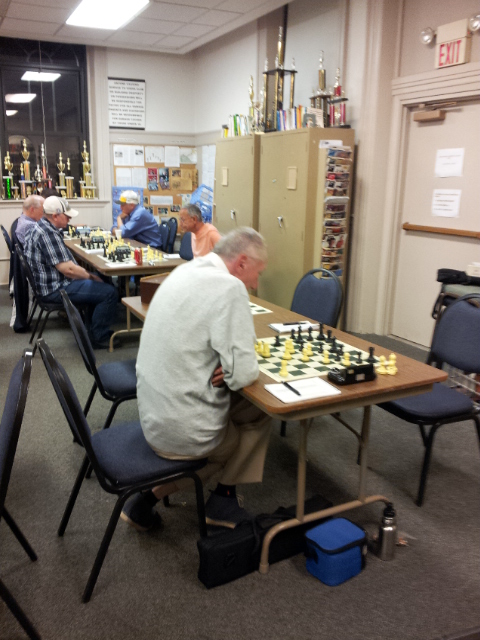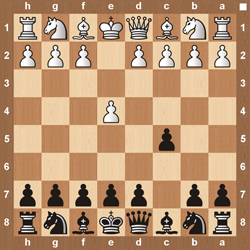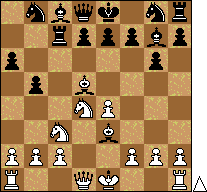Round 2 of the Pittsburgh Chess Club tournament: winning in the Sicilian Defense; the philosophy and psychology of struggle
Sep 12, 2012 · 7 minute read · CommentschessPittsburghPittsburgh Chess ClubSicilian Defense

Second round
Yesterday was the second round of the current six-round Tuesday night tournament at the Pittsburgh Chess Club, the 14th Fred Sorensen Memorial.
Last week I reported on my quick “Greek gift sacrifice” win in the first round. This week, my game was far from quick: it was a long struggle lasting most of the allotted four-hour maximum; my game lasted over three hours before I finally won.
In this post, I frankly discuss the course of the game, including the crucial psychological aspects.
I begin with a summary of the basic philosophical concepts of the opening, the Sicilian Defense, in terms that I hope both novices and non-chess-players can appreciate.
Playing as Black in chess
When one is playing as Black in chess, there are two philosophies of how to face White:
- defend against and neutralize White’s first move advantage, by also occupying the center and holding it against White’s attack
- ignore White’s game plan, and choose to start an indirect counter-attack on White
The first option is safest, while the second option is risky.
Brief introduction to the Sicilian Defense
In the Sicilian Defense, the second, very aggressive option is chosen: the basic idea is the Black on the very first move unbalances the position, taunting White, saying, “attack my King if you dare, but I’m going for your Queen side”. Whereas White has claimed the center with the e Pawn, Black plays on the flank with the c Pawn:

Sicilian Defense
The Sicilian Defense in chess is, in my view, the most exciting of all chess openings for Black.
The critical lines in the open Sicilian are those in which White takes up Black’s challenge head on and opens up the position by allowing Black to trade the c Pawn for White’s d Pawn. For example (as in my game yesterday):

Najdorf Variation
I have played both sides of the Sicilian
Playing this opening as Black is not for the faint of heart. Famous temperamental, attacking players such as Bobby Fischer and Garry Kasparov used it as their weapon of choice during their careers.
I did not play the Sicilian Defense as Black as a kid. I only started playing it as an adult as part of my reinvention of myself as a chess player when returning to the game after a twenty-year absence. I had shied away from the Sicilian because of a desire to be different (it’s a popular opening) and because of laziness (I did not want to study a lot of opening theory).
In fact, when I was a kid, I liked nothing better than playing the White side of the Sicilian. I loved destroying Black in the Sicilian.
During my time in the past couple of years finally starting to play the Sicilian Defense as Black, I have suffered some horrendous quick losses as Black, in which my King was hunted down and destroyed as White Pawns and pieces crashed through my defenses. But I have also enjoyed some really exciting wins as Black as I fended off White’s attack and destroyed White’s Queen side and center.
Black’s goals
In the critical lines of the open Sicilian, Black’s goal is to defend accurately against any attacks by White while slowly building up a counter-attack. The hope is that as White’s attack out of the opening fails and becomes overextended, Black will be in position to explode and rip White apart. It’s an exciting way to play.
Here is an example of a great position for Black (in the game I just played yesterday):

Prokhov-Chen
Notice that Black is still far behind in King side development, but has managed to take control of the Queen side and center away from White. Black has a clear advantage here, but no win yet, and must play precisely to maintain the advantage and not fall into danger.
(In fact, at this very moment in the game, I started playing poorly. More on that later.)
White’s goals
In the critical lines of the open Sicilian, White’s goal is to find tactics in order to break through to Black’s King before Black has any chance to do anything useful in return.
Here is an example of a great position for White, from a “brilliancy” I played in 1985:

Chen-Winfield, Michigan Open 1985
Notice that Black is far behind in piece development, and White already has pieces mobilized against Black’s King, and in fact has a won game.
When White plays well and Black plays poorly in the Sicilian Defense, the result is usually a brutal win for White (as it was in this old game of mine).
My game
As Black yesterday, I faced an opponent I have played several tournament games with over the years. He always plays aggressively. All my games with him have been very tense, with a lot of tactics in the air and many opportunities for both sides to go wrong at critical moments.
The opening
I played the Sicilian against him, and by move eight the battle lines had already been drawn: in an English Attack, he was attacking my King side with the Pawn advance g4 and I was attacking his Queen side with the Pawn advance b5.
He played the opening inaccurately and I obtained a thematic Black advantage.
The middle
Unfortunately, at a critical position, I chose an inferior continuation that left me with no remaining advantage.
Psychologically, it’s always difficult when you are playing a chess game and realize that you have made a mistake and that all the work you did to secure an advantage is gone. Objectively, the correct thing to do is to stay calm and play the position as it exists in the present, rather than dwell on the past, but this is easier said than done.
I find that it is easy to slip into one of two errors at such critical turning points:
- get angry about losing advantage, and desperately make aggressive moves to try to reclaim an advantage
- get fearful of losing even more ground, and pre-emptively become passive and defensive
In this game, I leaned into the second failure mode. At first, I was tempted to go the first route, by continuing my Queen side attack without regard for my King. It’s possible that, without the anger component, such an attack was justifiable (a computer might choose it). But I knew that my mind was unbalanced and that I might not be able to properly fend off an attack on my King. So I took the conservative way out, by planning to put my King into safety. As a result, I allowed White to get a fine middle game position, but I saved energy to recoup mentally.
After my King was safe, I restarted my Queen side attack, even though objectively the chances of its success were by now very low.
However, White fell prey to psychology as well. My opponent must have been trying to achieve a draw, because instead of playing aggressively, he blocked up the Pawns and then tried to trade off all our Rooks to go into what he thought was a safe endgame for him.
The end
I became more and more confident about my chances as he embarked on this defensive course of action, because it showed the psychologically, he was not able to understand that he had a clear advantage he could exploit. My realization that he was faltering mentally made me regain my poise and focus and I played to make the most of my position.
Then at a critical point, when my attacking plans were about to reach an end, he panicked and played a blunder that enabled me to win a Pawn for nothing.
At this point, it was still possible for him to have defended well and maybe even drawn, despite the Pawn deficit. But instead, he continued to fall apart. I took care to play very precisely to take control of the situation on the board, and after fourteen moves (played in 73 minutes; he took 29 minutes to think while I took 44 minutes to think), he resigned.
I was proud of how I came back from a seemingly lifeless, drawn position to restore my mental state to one of objective calculation, and secure the win after his blunder of a Pawn.
The annotated game
Enjoy playing over the game with my annotations, including diagrams!
Conclusion
Winning my game in round 2 was not easy. I let my opening advantage peter out, became discouraged, regrouped mentally, then was lucky that my opponent blundered and gave me a chance to win the game all over again, and I did. This is the life cycle of many chess games between humans.